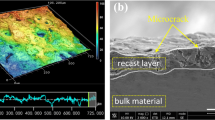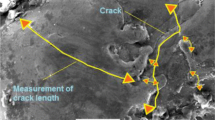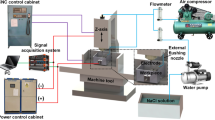Abstract
In recent years, the popularity of nickel-based super alloys has been on the rise due to their widespread application in oil and gas, aerospace and automobile, marine and biomedical industries. The unique combination of superior mechanical and chemical properties like hardness, strength, temperature and corrosion resistance is responsible for the extensive application of these alloys. However, these properties pose challenges during the conventional machining of nickel-based super alloys. The low thermal conductivity and high work-hardening characteristics of Inconel 718 make it difficult to machine. To overcome the aforementioned problem, a hybrid non-contact electrical discharge and arc-machining process has been employed. In this process, an additional DC power supply is employed in conjunction with the normal EDM-pulsed power supply. Furthermore, the selection of proper electrode material plays an important role in defining the machining performance. In this study, in order to select a suitable electrode material for the newly developed process, several experimental investigations have been conducted with three different electrode materials, namely brass, copper (Cu) and copper tungsten (CuW). The results have shown that, for all the current settings, brass electrode provides the highest material removal rate (MRR), followed by Cu and CuW electrodes. However, CuW exhibited the lowest electrode wear rate (EWR). Moreover, the average surface roughness and surface characteristics of the electrodes after machining were investigated as well. Based on all the performance parameters, CuW appears to be the best choice for the hybrid process to machine Inconel 718.












Similar content being viewed by others
References
Dudzinski D et al (2004) A review of developments towards dry and high speed machining of Inconel 718 alloy. Int J Mach Tools Manuf 44(4):439–456
Rahman M, Seah WKH, Teo TT (1997) The machinability of Inconel 718. J Mater Process Technol 63(1–3):199–204
Sharman ARC, Hughes JI, Ridgway K (2006) An analysis of the residual stresses generated in Inconel 718™ when turning. J Mater Process Technol 173(3):359–367
Leskovar P, Ferlan D, Kovač M (1987) Residual stresses as essential criteria for the evaluation of production processes. CIRP Ann Manuf Technol 36(1):409–412
Ezugwu EO, Tang SH (1995) Surface abuse when machining cast iron (G-17) and nickel-base superalloy (Inconel 718) with ceramic tools. J Mater Process Technol 55(2):63–69
Kunieda M et al (2005) Advancing EDM through fundamental insight into the process. CIRP Ann Manuf Technol 54(2):64–87
Tanjilul M, Ahmed A, Kumar AS, Rahman M (2018) A study on EDM debris particle size and flushing mechanism for efficient debris removal in EDM-drilling of Inconel 718. J Mater Process Technol 255:263–274
Ahmed A, Lew MT, Diwakar P, Kumar AS, Rahman M (2019) A novel approach in high performance deep hole drilling of Inconel 718. Precis Eng 56:432–437
Tsai Y-Y, Masuzawa T (2004) An index to evaluate the wear resistance of the electrode in micro-EDM. J Mater Process Technol 149(1–3):304–309
Singh S, Maheshwari S, Pandey PC (2004) Some investigations into the electric discharge machining of hardened tool steel using different electrode materials. J Mater Process Technol 149(1–3):272–277
Khan AA (2008) Electrode wear and material removal rate during EDM of aluminum and mild steel using copper and brass electrodes. Int J Adv Manuf Technol 39(5–6):482–487
Shen Y, Liu Y, Zhang Y, Dong H, Sun P, Wang X et al (2016) Effects of an electrode material on a novel compound machining of inconel718. Mater Manuf Process 31(7):845–851
Tsai HC, Yan BH, Huang FY (2003) EDM performance of Cr/Cu-based composite electrodes. Int J Mach Tools Manuf 43(3):245–252
Curodeau A, Richard M, Frohn-Villeneuve L (2004) Molds surface finishing with new EDM process in air with thermoplastic composite electrodes. J Mater Process Technol 149(1–3):278–283
El-Taweel TA (2009) Multi-response optimization of EDM with Al–Cu–Si–TiC P/M composite electrode. Int J Adv Manuf Technol 44(1–2):100–113
Zaw HM, Fuh JYH, Nee AYC, Lu L (1999) Formation of a new EDM electrode material using sintering techniques. J Mater Process Technol 89:182–186
Ahmed A (2016) Deposition and analysis of composite coating on aluminum using Ti–B4C powder metallurgy tools in EDM. Mater Manuf Process 31(4):467–474
Zhao J, Li Y, Zhang J, Yu C, Zhang Y (2003) Analysis of the wear characteristics of an EDM electrode made by selective laser sintering. J Mater Process Technol 138(1–3):475–478
Amorim FL, Lohrengel A, Müller N, Schäfer G, Czelusniak T (2013) Performance of sinking EDM electrodes made by selective laser sintering technique. Int J Adv Manuf Technol 65(9–12):1423–1428
Lonardo PM, Bruzzone AA (1999) Effect of flushing and electrode material on die sinking EDM. CIRP Ann Manuf Technol 48(1):123–126
Amorim FL, Weingaertner WL (2007) The behavior of graphite and copper electrodes on the finish die-sinking electrical discharge machining (EDM) of AISI P20 tool steel. J Braz Soc Mech Sci Eng 29(4):366–371
Lee HT, Hsu FC, Tai TY (2004) Study of surface integrity using the small area EDM process with a copper–tungsten electrode. Mater Sci Eng A 364(1–2):346–356
Uhlmann E, Roehner M (2008) Investigations on reduction of tool electrode wear in micro-EDM using novel electrode materials. CIRP J Manuf Sci Technol 1(2):92–96
Trych-Wildner A, Wildner K (2017) Multifilament carbon fibre tool electrodes in micro EDM—evaluation of process performance based on influence of input parameters. Int J Adv Manuf Technol 91(9–12):3737–3747
Khanra AK, Sarkar BR, Bhattacharya B, Pathak LC, Godkhindi MM (2007) Performance of ZrB2–Cu composite as an EDM electrode. J Mater Process Technol 183(1):122–126
Rahman MM, Khan MAR, Kadirgama K, Noor MM, Bakar RA (2010) Modeling of material removal on machining of Ti-6Al-4V through EDM using copper tungsten electrode and positive polarity. World Acad Sci Eng Technol 71:576–581
Bhaumik M, Maity K (2018) Effect of different tool materials during EDM performance of titanium grade 6 alloy. Eng Sci Technol Int J 21(3):507–516
Ahmed A, Fardin A, Tanjilul M, Wong YS, Rahman M, Kumar AS (2018) A comparative study on the modelling of EDM and hybrid electrical discharge and arc machining considering latent heat and temperature-dependent properties of Inconel 718. Int J Adv Manuf Technol 94(5–8):2729–2737
Xu H, Gu L, Chen J, Hu J, Zhao W (2015) Machining characteristics of nickel-based alloy with positive polarity blasting erosion arc machining. Int J Adv Manuf Technol 79(5–8):937–947
Jahan MP, Rahman M, Wong YS (2011) A review on the conventional and micro-electrodischarge machining of tungsten carbide. Int J Mach Tools Manuf 51(12):837–858
Ahmed A, Tanjilul M, Fardin A, Wong YS, Rahman M, Kumar AS (2018) On the design and application of hybrid electrical discharge and arc machining process for enhancing drilling performance in Inconel 718. Int J Adv Manuf Technol 99(5–8):1825–1837
Acknowledgements
The authors would like to thank Dr. S. Panda and Mr. J. Adhikari for their help and support to fabricate the integrated circuit.
Funding
This work was funded by A*Star (Grant No: R265-000-534-305) and Singapore Institute of Manufacturing Technology (SIMTech) (Grant No: R265-000-518-504).
Author information
Authors and Affiliations
Corresponding author
Additional information
Publisher’s note
Springer Nature remains neutral with regard to jurisdictional claims in published maps and institutional affiliations.
Rights and permissions
About this article
Cite this article
Ahmed, A., Tanjilul, M., Rahman, M. et al. Ultrafast drilling of Inconel 718 using hybrid EDM with different electrode materials. Int J Adv Manuf Technol 106, 2281–2294 (2020). https://doi.org/10.1007/s00170-019-04769-w
Received:
Accepted:
Published:
Issue Date:
DOI: https://doi.org/10.1007/s00170-019-04769-w




